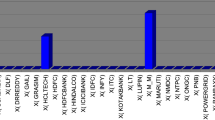Abstract
This work concerns a suitable range of optimal portfolio compositions as well as their optimal returns in the mean absolute deviation portfolio selection model when a threshold return expected from the investment is given. Disagreement in measurements of expected future asset returns is resolved by the alternative representation of their intervals. The nonlinear behavior of the resultant parametric model with its nonconvex feasible region is discussed in detail. Constraints used in achieving exact bounds can be relaxed for faster computation and more accurate results, leading to relaxed bounds which can be improved by basis stability. This is particularly useful for a securities company to create more appealing advertisement on its financial products and also for an investor to screen out unfavorable assets from a variety of instruments to spend less time on and reduce expenses incurred in the process of fundamental and technical analysis. The relaxed bounds are compared with the bounds obtained by bilevel and nonlinear approaches.

Similar content being viewed by others
References
Allahdadi M, Nehi HM (2013) The optimal solution set of the interval linear programming problems. Optim Lett 7(8):1893–1911
Bazaraa MS, Sherali HD, Shetty CM (2013) Nonlinear programming: theory and algorithms. Wiley, New York
Black F, Scholes M (1973) The pricing of options and corporate liabilities. J Polit Econ 81(3):637–654
Borrelli Bemporad A, Morari M (2003) Geometric algorithm for multiparametric linear programming. J Optim Theory Appl 118(3):514–540
Chaiyakan S, Thipwiwatpotjana P (2019) Mean absolute deviation portfolio frontiers with interval-valued returns. In: Seki H, Nguyen CH, Huynh VN, Inuiguchi M (eds) Integrated uncertainty in knowledge modelling and decision making (lecture notes in computer science, vol 11471). Springer International Publishing, Cham, pp 222–234
Charitopoulos VM, Papageorgion LG, Dua V (2017) Multi-parametric linear programming under global uncertainty. AIChE J 63(9):3871–3895
Cizek P, Härdle WK, Weron R (2005) Statistical tools for finance and insurance. Springer, Berlin
Fama EF (1965) The behavior of stock-market prices. J Bus 38(1):34–105
Fama EF, French KR (1996) Multifactor explanations of asset pricing anomalies. J Finance 51(1):55–84
Fang Y, Lai KK, Wang S (2008) Fuzzy portfolio optimization. Springer, Berlin
Feinstein CD, Thapa MN (1993) A reformulation of a mean-absolute deviation portfolio optimization model. Manage Sci 39(12):1552–1553
Fiedler M, Nedoma J, Ramík J, Rohn J, Zimmermann K (2006) Linear optimization problems with inexact data. Springer, Berlin
Guillaume DM, Dacorogna MM, Davé RR, Müller UA, Olsen RB, Pictet OV (1997) From the bird’s eye to the microscope: A survey of new stylized facts of the intra-daily foreign exchange markets. Finance Stochast 1(2):95–129
Gupta P, Mehlawat MK, Inuiguchi M, Chandra S (2014) Fuzzy portfolio optimization. Springer, Berlin
Hladík M (2009) Optimal value range in interval linear programming. Fuzzy Optim Decis Making 8(3):283–294
Hladík M (2014) How to determine basis stability in interval linear programming. Optim Lett 8(1):375–389
Kadan O, Tang X (2019) A bound on expected stock returns. Rev Financ Stud 33(4):1565–1617
Konno H, Yamazaki H (1991) Mean-absolute deviation portfolio optimization model and its applications to tokyo stock market. Manage Sci 37(5):519–531
Lai KK, Wang SY, Xu JP, Zhu SS, Fang Y (2002) A class of linear interval programming problems and its application to portfolio selection. IEEE Trans Fuzzy Syst 10(6):698–704
Liu ST (2011) The mean-absolute deviation portfolio selection problem with interval-valued returns. J Comput Appl Math 235(14):4149–4157
Luo J, Li W (2013) Strong optimal solutions of interval linear programming. Linear Algebra Appl 439(8):2479–2493
Mansini R, Ogryczak W, Speranza MG (2014) Twenty years of linear programming based portfolio optimization. Eur J Oper Res 234(2):518–535
Markowitz H (1952) Portfolio selection. J Finance 7(1):77–91
Martin I (2017) What is the expected return on the market? Q J Econ 132(1):367–433
Mathworks (2020) Global optimization toolbox user’s guide. http://www.mathworks.com/help/gads/index.html. Accessed 30 Dec 2020
McNeil AJ, Frey R, Embrechts P (2005) Quantitative risk management: concepts, techniques and tools. Princeton University Press, Princeton
Merton RC (1973) An intertemporal capital asset pricing model. Econometrica 41(5):867–887
Rachev S, Mittnik S (2000) Stable Paretian models in finance. Wiley, New York
Ramík J, Stavárek D (eds) (2012) An interval linear programming contractor, Silesian University in Opava
Rohn J (1993) Stability of the optimal basis of a linear program under uncertainty. Oper Res Lett 13(1):9–12
Sharpe WF (1964) Capital asset prices: a theory of market equilibrium under conditions of risk. J Finance 19(3):425–442
Speranza MG (1994) Linear models for portfolio selection and their application to the milano stock market. In: Peccati L, Virén M (eds) Financial modelling. Physica-Verlag HD, Heidelberg, pp 320–333
Trippi RR (1992) A note on modifying the mean-absolute deviation portfolio optimization model to account for nonstationarity biases. Financ Manage 21(4):20
Wittmann-Hohlbein M, Pistikopoulos EN (2013) On the global solution of multi-parametric mixed integer linear programming problems. J Global Optim 57(1):51–73
Yue W, Wang Y (2015) A fuzzy multi-objective portfolio selection model with transaction cost and liquidity. In: 2015 11th international conference on computational intelligence and security (CIS), pp 258–261
Zhang P (2016) An interval mean-average absolute deviation model for multiperiod portfolio selection with risk control and cardinality constraints. Soft Comput 20(3):1203–1212
Author information
Authors and Affiliations
Corresponding author
Ethics declarations
Conflict of interest
The authors declare that they have no conflict of interest.
Additional information
Publisher's Note
Springer Nature remains neutral with regard to jurisdictional claims in published maps and institutional affiliations.
Rights and permissions
About this article
Cite this article
Chaiyakan, S., Thipwiwatpotjana, P. Bounds on mean absolute deviation portfolios under interval-valued expected future asset returns. Comput Manag Sci 18, 195–212 (2021). https://doi.org/10.1007/s10287-021-00392-x
Received:
Accepted:
Published:
Issue Date:
DOI: https://doi.org/10.1007/s10287-021-00392-x




